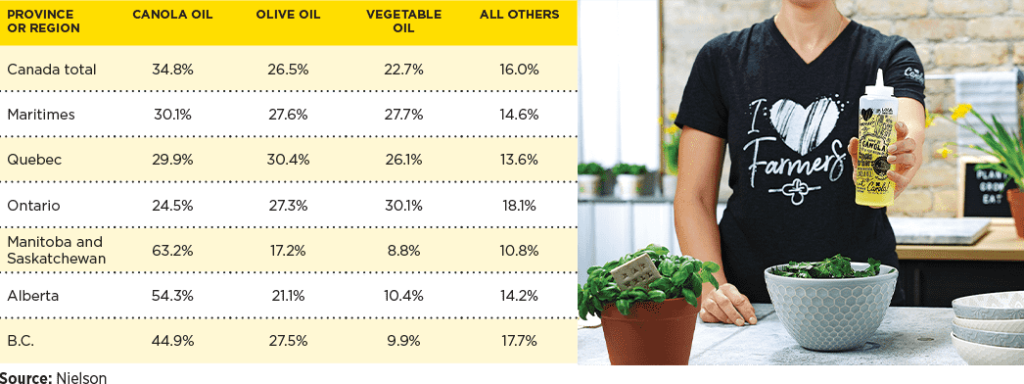Pathway To Boost Canola Oil Usage In Ontario
Consumer surveys show that canola oil lags olive oil in the Ontario market. Canola Eat Well can use data on consumer preferences and decision drivers to create canola oil promotion strategies for Canada’s biggest market.
While canola oil is the most used oil in Western Canada, the same can’t be said for Ontario, home to almost 40 per cent of Canada’s population. Only 18 per cent of Ontario’s population are “core” canola oil users – people who use canola oil for at least half of their oil purposes.
Canola Eat Well, a joint partnership between Alberta Canola, Manitoba Canola Growers and SaskCanola, works to connect Canadians with canola oil. A key target is the big Ontario market. Canola Eat Well hired Kynetec to survey Ontarians to track their cooking oil purchases and the reasons for their decisions. The goal is to look for more effective messages to increase the number of core and casual users.
“We need to understand Ontario consumers in order to develop promotional strategies that address their needs and concerns,” says Lynn Weaver, promotions manager and Canola Eat Well lead for SaskCanola.
In 2021, Kynetec surveyed 1,000 primary grocery shoppers in Ontario. Then they compared 2016 survey results to check on progress and changing preferences.
The survey divided respondents into three groups:
- Core canola oil users – Over the past 12 months, they used canola oil at least 50 per cent of the time.
- Casual users – They use canola oil, but less than half the time.
- Non users/infrequent users – These consumers did not use canola oil in the four weeks leading up to the survey date.
In 2021, 18 per cent of Ontarians were core users, 33 per cent were casual users and 49 per cent were non or infrequent users. These splits have not changed significantly since 2016, but awareness of canola oil among non users has gone down.
Olive oil is the dominant oil in Ontario. Overall, 85 per cent of Ontario households have olive oil on the shelf, compared to 56 per cent for canola oil and 49 per cent for vegetable oil (which is usually soybean oil).
For deep frying, vegetable oil is the first choice followed closely by canola oil. For baking, canola oil has a slight edge, although all three are fairly close. Olive oil leads in all other uses, from sautéing to salad dressing and sauces.
Cooking oil market share across Canada
Neilsen data shows cooking oil retail sales for Canada and for each province. Nationally, canola oil led with 34.8 per cent retail volume market share in 2020, based on litres sold. Olive oil is next at 26.5 per cent and vegetable oil is third at 22.7 per cent. In terms of dollar share, olive oil is way out front, capturing 48.2 per cent of the retail spend on cooking oils in 2020. Canola oil is second at 17.2 per cent.

Focus On Versatility
In terms of target messaging, Canola Eat Well will focus on the 33 per cent of Ontarians in the “casual users” group, as these users are probably more likely than non-users to increase canola oil usage.
“Casual users often have canola oil at home. We want to show them how canola oil’s versatility is its advantage, especially compared to vegetable oil,” Weaver says. Key drivers for oil purchases relate to versatility, with “it is a good fit for the way I cook” being the top choice. Factors in canola’s favour – “good choice for high temperature cooking”, “it’s affordable” and “made in Canada” – are not major driving factors behind oil choices in Ontario.
The healthy message could have more traction, Weaver says. The survey shows that people perceive olive oil as the healthiest. When primary grocery shoppers were asked why they use olive oil, the most common answers were “healthier than other oils”, “like the taste” and “recipes call for olive oil”. Canola oil has a strong health message. Canola oil is low in saturated fat and a source of omega-3 polyunsaturated fatty acids.
“We need to keep talking to people about the healthiness of canola oil,” Weaver says. Since 2016, more people say they perceive canola oil as unhealthy (23 per cent in 2021, up from 17 per cent in 2016). On a positive note, only two per cent mention GMO when asked for their perception of canola oil, down from seven per cent in 2016.
“This information will continue to inform our tactics going forward,” says Jennifer Dyck, market development director and Canola Eat Well lead for Manitoba Canola Growers. “Canola Eat Well aims to meet the consumer where they’re at, and this data is valuable intel that will help to shift messaging and programs as required.”
Data clearly show that Ontario remains an opportunity for growth. “Our previous years working with key opinion leaders set us up well to continue into 2022 and beyond,” Dyck says, adding, “It’s important to note that we value the dedicated Western Canadian user and will continue to maintain a provincial presence within those markets as well.”
“We need to understand Ontario consumers in order to develop promotional strategies that address their needs and concerns.”
–Lynn Weaver





